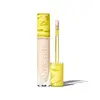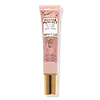Kosas Revealer Super Creamy + Brightening Concealer Versus Winky Lux Peeper Perfect Under-Eye Concealer
What's inside
What's inside
 Key Ingredients
Key Ingredients

 Benefits
Benefits

 Concerns
Concerns

 Ingredients Side-by-side
Ingredients Side-by-side

Water
Skin ConditioningCaprylic/Capric Triglyceride
MaskingMica
Cosmetic ColorantOctyldodecanol
EmollientPolyglyceryl-2 Dipolyhydroxystearate
Skin ConditioningEthylhexyl Olivate
Skin ConditioningUndecane
EmollientGlycerin
HumectantPolyhydroxystearic Acid
EmulsifyingTridecane
PerfumingPolyglyceryl-3 Diisostearate
EmulsifyingGalactoarabinan
Helianthus Annuus Seed Wax
Skin ConditioningArnica Montana Flower Extract
MaskingCaffeine
Skin ConditioningDunaliella Salina Extract
Skin ConditioningFoeniculum Vulgare Oil
EmollientGlyceryl Oleate
EmollientHelianthus Annuus Seed Oil
EmollientLecithin
EmollientMaltodextrin
AbsorbentPalmitoyl Tripeptide-5
Skin ConditioningPanthenol
Skin ConditioningRosmarinus Officinalis Extract
AntimicrobialSodium Hyaluronate
HumectantSqualane
EmollientTocopherol
AntioxidantPotassium Sorbate
PreservativeSodium Benzoate
MaskingWater, Caprylic/Capric Triglyceride, Mica, Octyldodecanol, Polyglyceryl-2 Dipolyhydroxystearate, Ethylhexyl Olivate, Undecane, Glycerin, Polyhydroxystearic Acid, Tridecane, Polyglyceryl-3 Diisostearate, Galactoarabinan, Helianthus Annuus Seed Wax, Arnica Montana Flower Extract, Caffeine, Dunaliella Salina Extract, Foeniculum Vulgare Oil, Glyceryl Oleate, Helianthus Annuus Seed Oil, Lecithin, Maltodextrin, Palmitoyl Tripeptide-5, Panthenol, Rosmarinus Officinalis Extract, Sodium Hyaluronate, Squalane, Tocopherol, Potassium Sorbate, Sodium Benzoate
Water
Skin ConditioningParaffinum Liquidum
EmollientPropylene Glycol
HumectantEthylhexyl Palmitate
EmollientHexyl Laurate
EmollientPetrolatum
EmollientGlycerin
HumectantPEG-30 Dipolyhydroxystearate
EmulsifyingDicaprylyl Maleate
EmollientPolyglyceryl-2 Dipolyhydroxystearate
Skin ConditioningCetyl Alcohol
EmollientStearyl Alcohol
EmollientBentonite
AbsorbentCera Alba
EmollientLecithin
EmollientSilica Dimethyl Silylate
EmollientTrimethylolpropane Tricaprylate/Tricaprate
EmollientDimethicone
EmollientMagnesium Sulfate
Tocopherol
AntioxidantPhenoxyethanol
PreservativeOlea Europaea Fruit Oil
MaskingChlorphenesin
AntimicrobialTheobroma Grandiflorum Seed Butter
Skin ConditioningHydrolyzed Collagen
EmollientEthylhexylglycerin
Skin ConditioningVitis Vinifera Seed Extract
AntimicrobialSodium Hyaluronate
HumectantCI 77891
Cosmetic ColorantCI 77491
Cosmetic ColorantCI 77492
Cosmetic ColorantCI 77499
Cosmetic ColorantWater, Paraffinum Liquidum, Propylene Glycol, Ethylhexyl Palmitate, Hexyl Laurate, Petrolatum, Glycerin, PEG-30 Dipolyhydroxystearate, Dicaprylyl Maleate, Polyglyceryl-2 Dipolyhydroxystearate, Cetyl Alcohol, Stearyl Alcohol, Bentonite, Cera Alba, Lecithin, Silica Dimethyl Silylate, Trimethylolpropane Tricaprylate/Tricaprate, Dimethicone, Magnesium Sulfate, Tocopherol, Phenoxyethanol, Olea Europaea Fruit Oil, Chlorphenesin, Theobroma Grandiflorum Seed Butter, Hydrolyzed Collagen, Ethylhexylglycerin, Vitis Vinifera Seed Extract, Sodium Hyaluronate, CI 77891, CI 77491, CI 77492, CI 77499
 Reviews
Reviews

Ingredients Explained
These ingredients are found in both products.
Ingredients higher up in an ingredient list are typically present in a larger amount.
Glycerin is already naturally found in your skin. It helps moisturize and protect your skin.
A study from 2016 found glycerin to be more effective as a humectant than AHAs and hyaluronic acid.
As a humectant, it helps the skin stay hydrated by pulling moisture to your skin. The low molecular weight of glycerin allows it to pull moisture into the deeper layers of your skin.
Hydrated skin improves your skin barrier; Your skin barrier helps protect against irritants and bacteria.
Glycerin has also been found to have antimicrobial and antiviral properties. Due to these properties, glycerin is often used in wound and burn treatments.
In cosmetics, glycerin is usually derived from plants such as soybean or palm. However, it can also be sourced from animals, such as tallow or animal fat.
This ingredient is organic, colorless, odorless, and non-toxic.
Glycerin is the name for this ingredient in American English. British English uses Glycerol/Glycerine.
Learn more about GlycerinLecithin is a term for a group of substances found in the cell membranes of plants, animals, and humans. They are made up of mixture of phospholipids.
This ingredient has emollient and emulsifying properties.
As an emollient, lecithen helps soften the skin and creates a barrier to keep moisture in.
As an emulsifier, it also helps prevent water and oil ingredients from separating. Lecithin can also help ingredients be better absorbed by the skin.
This is because the phospholipids in lecithin produce liposomes. Liposomes help other ingredients get through the skin barrier.
Depending on the source of this ingredient, lecithin may not be fungal acne safe. This is because some sources of lecithin come from soybean oil, which may feed the malassezia yeast that feeds fungal acne.
We recommend reaching out to the brand you are purchasing from to inquire about the source of their lecithin.
Some other names for this ingredient include soy lecithin and deoiled soy lecithin.
Learn more about LecithinPolyglyceryl-2 Dipolyhydroxystearate isn't fungal acne safe.
Sodium Hyaluronate is hyaluronic acid's salt form. It is commonly derived from the sodium salt of hyaluronic acid.
Like hyaluronic acid, it is great at holding water and acts as a humectant. This makes it a great skin hydrating ingredient.
Sodium Hyaluronate is naturally occurring in our bodies and is mostly found in eye fluid and joints.
These are some other common types of Hyaluronic Acid:
Learn more about Sodium HyaluronateTocopherol (also known as Vitamin E) is a common antioxidant used to help protect the skin from free-radicals and strengthen the skin barrier. It's also fat soluble - this means our skin is great at absorbing it.
Vitamin E also helps keep your natural skin lipids healthy. Your lipid skin barrier naturally consists of lipids, ceramides, and fatty acids. Vitamin E offers extra protection for your skin’s lipid barrier, keeping your skin healthy and nourished.
Another benefit is a bit of UV protection. Vitamin E helps reduce the damage caused by UVB rays. (It should not replace your sunscreen). Combining it with Vitamin C can decrease sunburned cells and hyperpigmentation after UV exposure.
You might have noticed Vitamin E + C often paired together. This is because it is great at stabilizing Vitamin C. Using the two together helps increase the effectiveness of both ingredients.
There are often claims that Vitamin E can reduce/prevent scarring, but these claims haven't been confirmed by scientific research.
Learn more about TocopherolWater. It's the most common cosmetic ingredient of all. You'll usually see it at the top of ingredient lists, meaning that it makes up the largest part of the product.
So why is it so popular? Water most often acts as a solvent - this means that it helps dissolve other ingredients into the formulation.
You'll also recognize water as that liquid we all need to stay alive. If you see this, drink a glass of water. Stay hydrated!
Learn more about Water